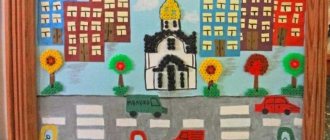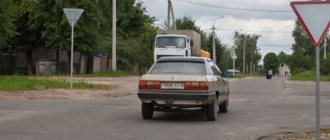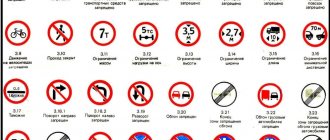Pictures of road signs
Clear drawings of signs with analogies will help you remember the most important symbols that you will encounter on your way to elementary school or kindergarten. Vivid images and simple explanations allow you to instantly attract attention and convey information quickly, cheerfully and clearly.
Thanks to road pictures, the child learns to be independent and make the right decisions. The main goal is to show that participation in traffic is not as scary as it may seem. If you understand the meaning of road signs, you can organize your own actions.
Road pictures are different for each age category. Children learn in the presence of an adult, who prompts actions and explains signs.
Child on the road
A child is alone on the street... So he runs up to the road to catch up with a runaway ball, and then a huge truck rushes towards him... Surely every parent has had such a terrible dream in their life at least once.
To prevent this nightmare from becoming a reality, it is necessary to begin teaching a child the correct behavior on the road from a very early age, long before he goes out on his own, unaccompanied by adults. Many methods have been developed to help parents learn; there are also special road signs for children, of course, toy ones, but do not forget that the child’s education should be of a playful nature. It is in the game that he will learn new material, new information much easier. Where is the best way to start learning?
Pictures of traffic rules for children
This is a fun activity for different age groups, which at the same time brings great benefits. Every child, just starting to walk, becomes a participant in traffic - goes to kindergarten or school, walks in the yard, learns to ride a bicycle. Studying from strict books is boring and difficult, so as an alternative we offer bright drawings with clear messages.
The learning process attracts the child with its accessibility and diversity. Any adult can help understand the images by adding examples from personal experience to the drawing. As a result, confidence in himself and his actions in any situation is formed, he will not be confused or scared at the sight of a moving car and will know what to do at a pedestrian crossing. Traffic rules drawings are quick answers to children's questions.
Road signs, methodological development for life safety (senior, preparatory group)
Road signs for children
As soon as your baby starts walking further than the playground near the house, he will certainly notice road signs. The most common signs for children are: “Pedestrian crossing”, “Children”, “Tram stop”, “Bus stop”, “No entry”. An inquisitive child will also see other signs, because sometimes he has to travel with his dad or mom.
Children who do not yet know how to read will not pay attention to the inscriptions on pillars or shop windows, but simple and bright traffic signs will definitely attract their attention.
I believe that a child should be taught road signs from an early age. From which one? Yes, from the moment your baby starts crossing the road with you or driving a car. Why not tell your child what a “Zebra” is and why there is a beautiful sign of a man walking along the stripes next to it. By the time your child starts kindergarten and first grade, he will already know the most basic road signs.
Today I want to show you pictures of “Traffic Signs”. Each picture with a sign will have a detailed and simple explanation. Pictures for children - Road signs
“Pedestrian crossing” is an information and directional sign.
It indicates the location of the ground crossing of the roadway. This sign is installed near special markings for pedestrians - zebra crossings.
Please pay attention to the child that there is another similar sign, but triangular. It is a warning (triangular) sign, also called a "Pedestrian Crossing". It does not indicate the crossing point for pedestrians, but warns the driver when approaching the crossing.
“Underground pedestrian crossing” is an information and directional sign. This sign indicates the location of the underground passage of the roadway. Installed near the entrance to the passage.
If you have an underground passage on the way to kindergarten or school, be sure to show it to your child.
“Tram stop location” is also an information and directional sign. He informs and points out to us that public transport stops at this location.
This sign is installed close to the landing area - the waiting area for passengers.
Parents should explain to the child that this road sign, like the previous one, is important for both pedestrians and drivers.
The pedestrian will find his way around where the stop is, and the driver will be careful, because there may be people (and especially children) at the stops.
When telling about this sign, be sure to repeat to your child how kids should behave at a stop (you can’t run or jump out onto the roadway).
“Bus stop location” is also an information and directional sign. He informs and points out to us that a bus stops at this place.
This sign is installed close to the landing area - the waiting area for passengers.
“Bike lane” is a prescriptive sign. Allows movement only on bicycles and mopeds. Other types of transport are not allowed to enter it. Pedestrians can also use the bike path if there is no sidewalk or pedestrian path.
If your child already knows how to ride a bicycle, then you should explain to him that he can only ride his bicycle horse in the courtyard of the house. And the one where there is such a sign.
Bike paths are designed specifically for cyclists. Perhaps your city has such areas for cycling.
“Pedestrian path” is a prescriptive sign. Sometimes there is a special path on the streets intended only for pedestrians.
On this path you must follow the general rules of behavior for pedestrians: stay on the right side; do not disturb other pedestrians.
Children should be explained that they are not allowed to play on the footpath or go sledding. Riding a bicycle on the pedestrian path is also prohibited.
“Entry prohibited” is a prohibitory sign. All prohibition signs are red.
This sign prohibits the entry of any vehicles, including bicycles, onto the section of road in front of which it is installed.
Its effect does not apply only to public transport, the routes of which pass through this section. A cyclist, upon seeing this sign, must get off the bicycle and drive it along the sidewalk, observing the rules for pedestrian traffic.
Remind your child that if he is carrying his bike rather than riding it, he is considered a pedestrian.
“No bicycles allowed” is another prohibitory sign. This sign prohibits the use of bicycles and mopeds. It is installed in places where riding a bicycle can be dangerous.
Typically this sign is placed on streets with heavy traffic.
It should be remembered that cycling is prohibited on highways, even if there is no prohibiting sign.
I believe that every child should know this sign and the rules associated with cycling, because children love to ride and, if possible, will want to ride on the road.
"Children" is a warning sign.
This sign warns the driver about the possible appearance of children on the road. It is installed near a child care facility, for example, a school, a health camp, or a playground.
But parents should warn the child that this sign does not indicate a place for children to cross the road! Therefore, a child pedestrian must cross the street in a place where pedestrian crossing is permitted and there is an appropriate sign.
“Pedestrian traffic prohibited” is a prohibitory sign.
This sign prohibits the movement of pedestrians. It is installed in places where walking can be dangerous.
This sign is often used to temporarily restrict pedestrian traffic, for example, during road works or renovation of house facades.
It should be remembered that pedestrian traffic is always prohibited on highways and roadways, even if a prohibitory sign is not installed.
Of course, this article does not cover all road signs. But those that you will see in our pictures are the signs most often encountered by pedestrians.
If you want to teach your child all the signs, you can download a picture and print out each road sign. With the help of these homemade road signs you can play with your child and teach him at the same time.
Simply cut out the signs, glue them to matches or toothpicks, place them in prepared plasticine holders and place them on the toy track.
Let the kid roll his car himself and tell you what kind of signs he meets on the way.
I recommend this video to everyone who loves creativity and origami!
Road alphabet in pictures
This is play-style learning. Vivid images are better remembered and attract children's attention better than dry texts and abstruse phrases. This alphabet has a dual function - visual teaching of literacy plus familiarization with road traffic and its participants. The child will easily remember the order of letters in the alphabet and their spelling, and will also know the designations of markings, signs, vehicles, etc.
The participation of an adult in the process of learning the alphabet can only be limited to testing the acquired knowledge. Colorful pictures and simple explanations are learned by children of different ages. As a result, the child is well oriented in traffic situations, learns in which places to cross the road, and will be able to distinguish between traffic lights and road sign designations.
Non-existent road signs
This is a great conceptual way to develop a child's understanding of the world. Based on simple drawings, the child develops logical thinking, associative perception, and adapts to social life. Road traffic is an integral part of modernity, vehicles and pedestrians intersect everywhere. Understanding the basics of traffic rules means being safe.
Pictures with non-existent road signs are beneficial because they develop in the child an idea of real symbols that need to be followed. At the same time, fantasy develops thanks to imaginary objects. Children easily reproduce or invent new colorful images. This learning process is built in a game format and is preparatory to further study of the signs from the Rules.
Road signs for children - a play option
As you probably guess, the first teaching aids for your baby will be toys, for example, small road signs for children, which can be bought at the nearest Detsky Mir store. They often come in the same set with cars or railroads. Before the child starts playing, show him each sign, tell him what it means, what it represents. Of course, for children’s perception it is necessary to use only those signs that they can understand (after all, not everything is still accessible to them due to their age!).
The most important road signs for children are signs from two groups: warning and prohibitory. The simplest and most understandable among them: two running men, a pedestrian crossing. Tell your child what this means, and then play together: let your favorite squirrel or bunny go for a walk, go out onto the road (where there will be small trucks and cars) and find the signs there. The child will explain to the bunny that where the road crossing is drawn, cars must stop, and the squirrel must cross the road. And seeing two running men in a triangle with a red border, the truck should drive very slowly and, if necessary, stop immediately: children may run out in front.
When the baby has mastered two or three warning signs, you can move on to prohibitive signs: these are those depicted in a circle with a red border. There are many of them, however, there is no point in forcing a child to memorize them all at once. Among such signs, the following are important: an image of a bicycle (bicycles are prohibited), a crossed out man (pedestrians are not allowed to walk). Remember: the main goal of your game (your educational lesson): the child must learn and understand the meaning of the most important signs for his life.
Be sure to tell him about the traffic light. Buy him a toy traffic light, let it shine either red, then yellow, or green, letting the toy men pass. Boys usually like this game more, because cars and everything connected with them often begin to interest them from early childhood. But even for a girl, the game can become entertaining if Vasilisa’s favorite doll, heading to kindergarten, acts as a pedestrian, and the car that has stopped to let her cross the road is pink, with a flirty bow on the bumper.







